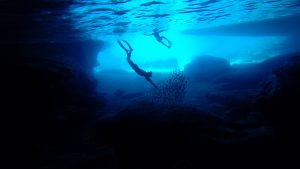
Curacao and the Floating Village
On the west coast of the island of Curacao lies Spanish Water, a large area of inland water that’s connected to the sea only by a narrow entrance. The protection from the sea is total and the surrounding hills provide some shelter from the wind. I went there for the 2017 hurricane season partly because it’s so well protected but mostly because it’s far to the south of the path hurricanes take.

Spanish Water
However, as I arrived the National Hurricane Centre (NHC) designated a storm in the Atlantic as a “potential tropical cyclone”. This developed into Tropical Storm Bret and headed straight for Curacao. “But I’m here because this doesn’t happen!” I protested, but Bret didn’t listen. My neighbours and I monitored the NHC and NOAA websites more or less obsessively, readied second anchors and battened down the hatches.
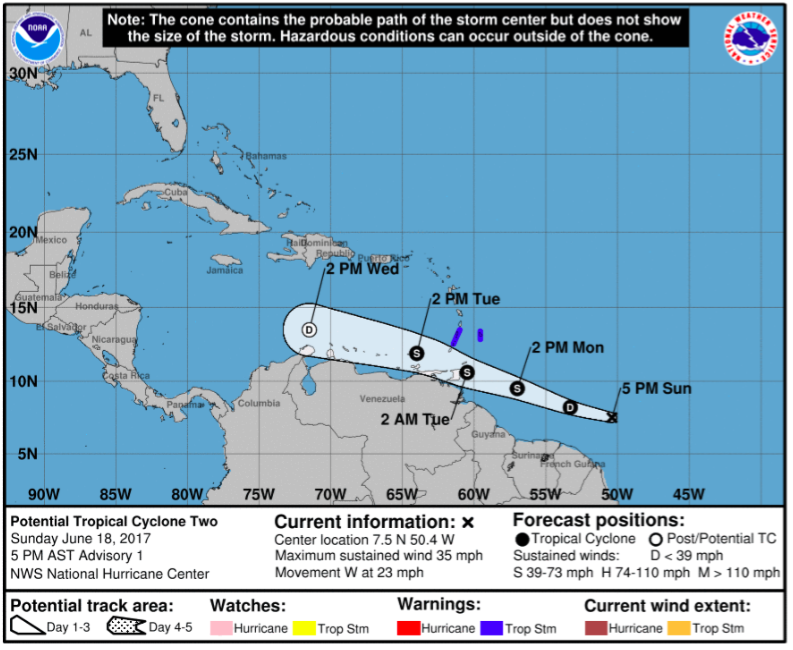
NOAA Forecast for Bret
In the event, although Bret wreaked havoc in Trinidad there were only strong winds in Curacao, boats dragging anchor and torrential rain. It was exciting rather than scary and there was no damage to Moonrise.
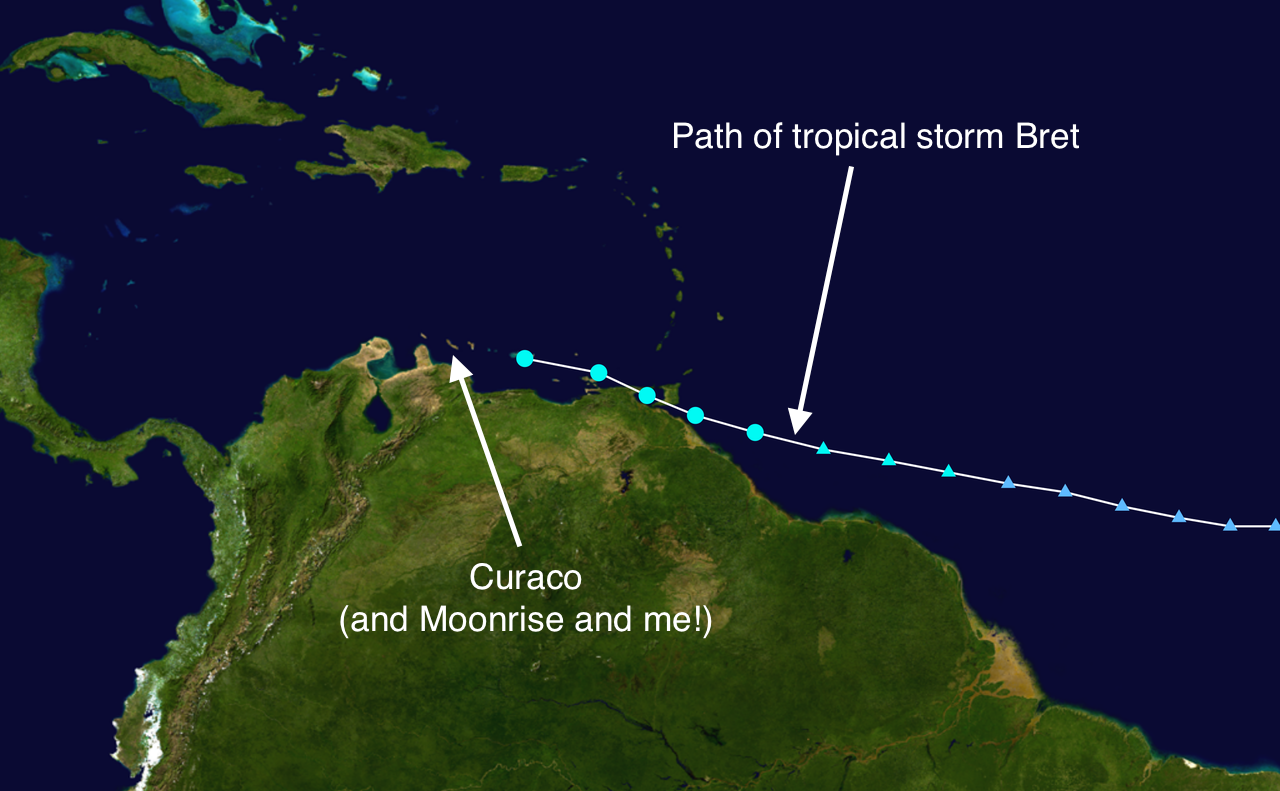
Actual Path of Bret
The season went on to be a record breaker. There were no fewer than three 500- year events within a few months of each other. According to Wikipedia:
- 2017 is the only season on record in which three hurricanes each had an ACE (accumulated cyclone energy) of over 40: Irma, Jose and Maria.
- Hurricane Harvey set the record for the most rainfall dropped by a tropical cyclone in the United States.
- Hurricane Irma became the first Category 5 hurricane to impact the northern Leeward Islandson record.
- In terms of maximum sustained winds, Irma is tied with the 1935 Labour Day hurricane as the strongest hurricane ever to make landfall in the Atlantic basin.
- Hurricane Maria was the first Category 5 hurricane to strike the island of Dominica on record.
- Hurricane Ophelia was the easternmost major hurricane in the Atlantic basin on record.
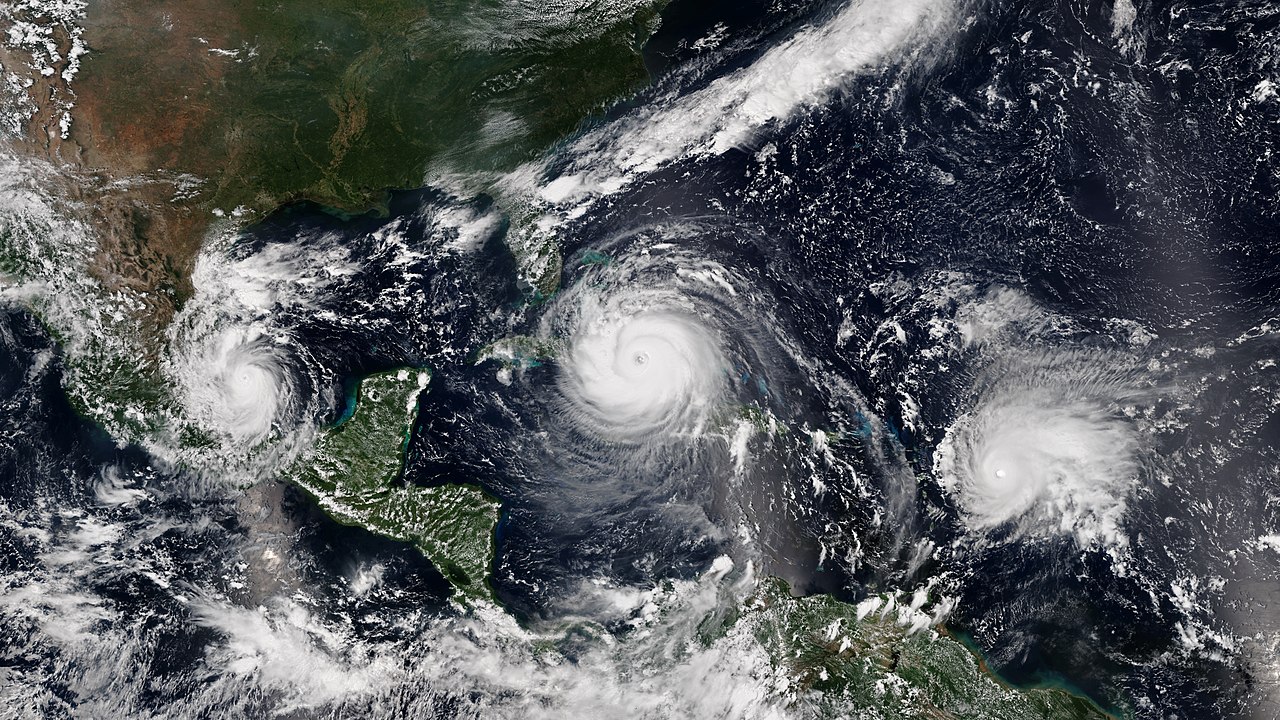
Katia, Irma and Jose
The devastation wreaked by these storms was well documented by the world’s media at the time so I shan’t repeat that here. What does stand out from this list, though, is the number of firsts. Things are definitely changing.
Seafarers have been gathering information on weather and sea conditions for centuries. Such bodies as the British Admiralty publish this accumulated data in pilot books. They describe what, on average over the passed several hundred years, can be expected in which areas and when. The trade winds blow reliably from here to there in these months and tropical storms can be expected in these areas in those months. Long voyages are planned using this historical data. The trick is to ensure you stay out of the stormy areas when storms can be expected and, rather than battling against them, use the trade winds and ocean currents to assist you on your way by ensuring your route and schedule aligns with them.
The trouble is, as the 2017 Atlantic hurricane season shows, old norms are breaking down. Storms are happening where and when they just haven’t in the past. Of course this is only one manifestation of a much wider issue that has profound ramifications. But on a personal level it remains to be seen how my own voyage will be affected in the years ahead, planned as it has been based on the pilot books’ historical data.
Meanwhile, as the catastrophe unfolded to the north, life went on in Spanish Water. I carried out the maintenance to Moonrise that I’d saved up to do at this time. I removed the stainless steel holding tank and took it ashore to be re-welded before reinstalling it again. I took down the old headlining from inside the boat and replaced it with new panels I cut from huge sheets of plywood. I installed two new clutches on the mast, replaced the engine’s exhaust mixer elbow and fuel pump, changed the inverter and, with help from Roy and Matthias (thank you both!) I stripped down and rebuilt my outboard engine no fewer than three times, fixed the jib’s roller furling foil and made numerous fiberglass repairs. So quite a lot got done though there was plenty of time so the pace was easy.
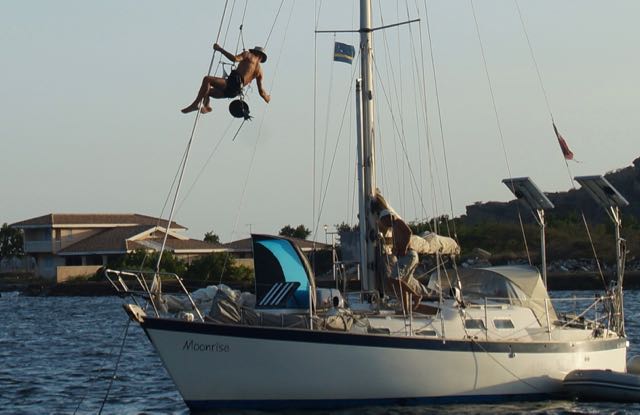
Fixing the Roller Furler Foil
There were also a few red-letter days. Curacao is not an island replete with recreational possibilities but there are four places that were firm favourites: the Tugboat, the Blue Room, Willemstad and Zanzibar.
Years ago a tugboat sank just off the coast in water shallow enough to make it possible to explore by snorkeling. It’s pretty cool to see the wreck, but on a good day it’s the many multicoloured fish that make it special. Conveniently, it’s within walking distance of the anchorage.
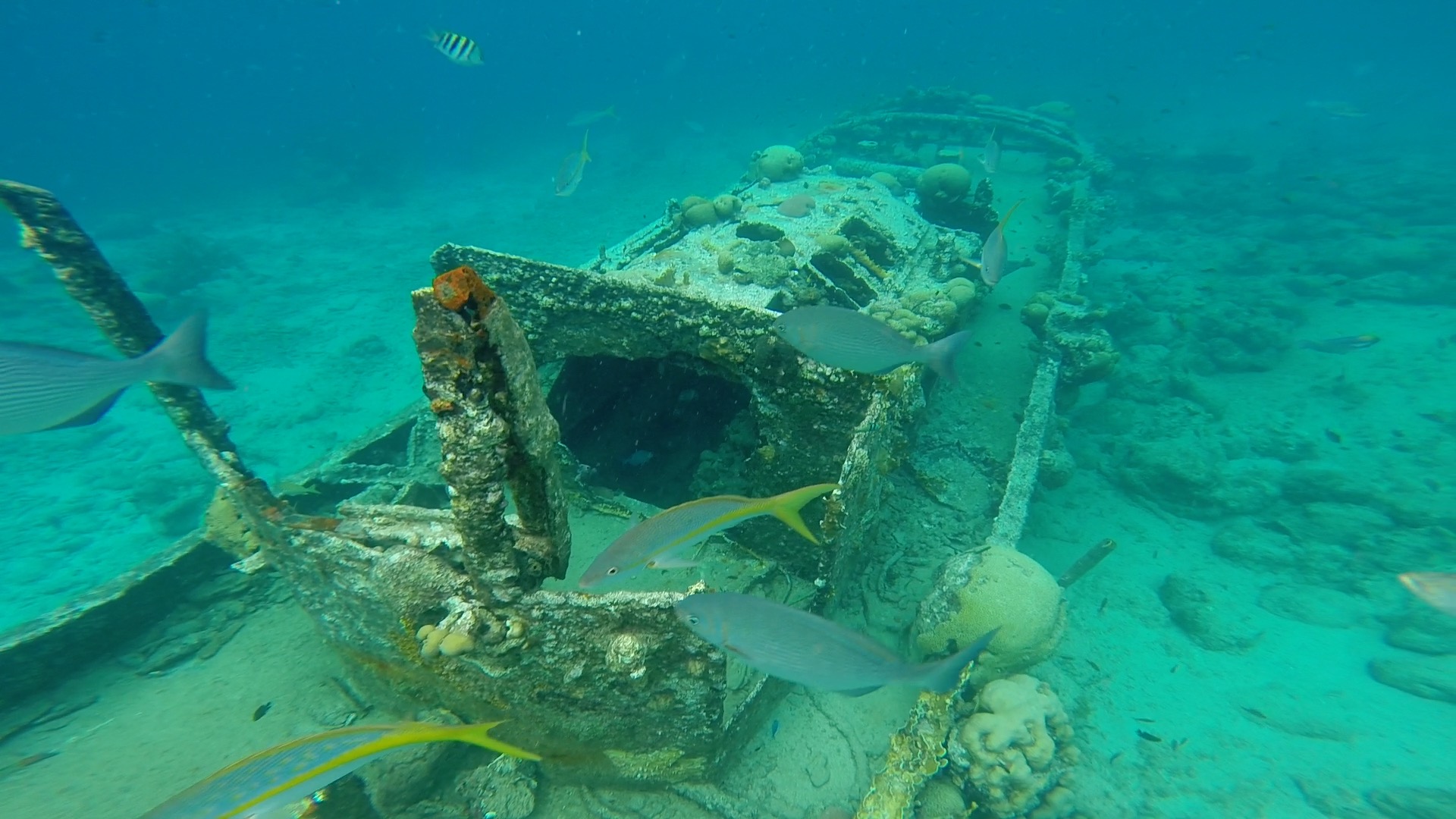
Tug Boat
The Blue Room is brilliant. It’s a way away on the island so you need to hire a car to get there, but my friends and I went several times. It’s a cave in the sea cliff the entrance to which is largely under water. This means not only that to get into the cave you have to jump off the cliff and swim in but also that most of the light inside the cave has come through the water so everything appears blue. It doesn’t sound that exciting but actually it’s a magical place.
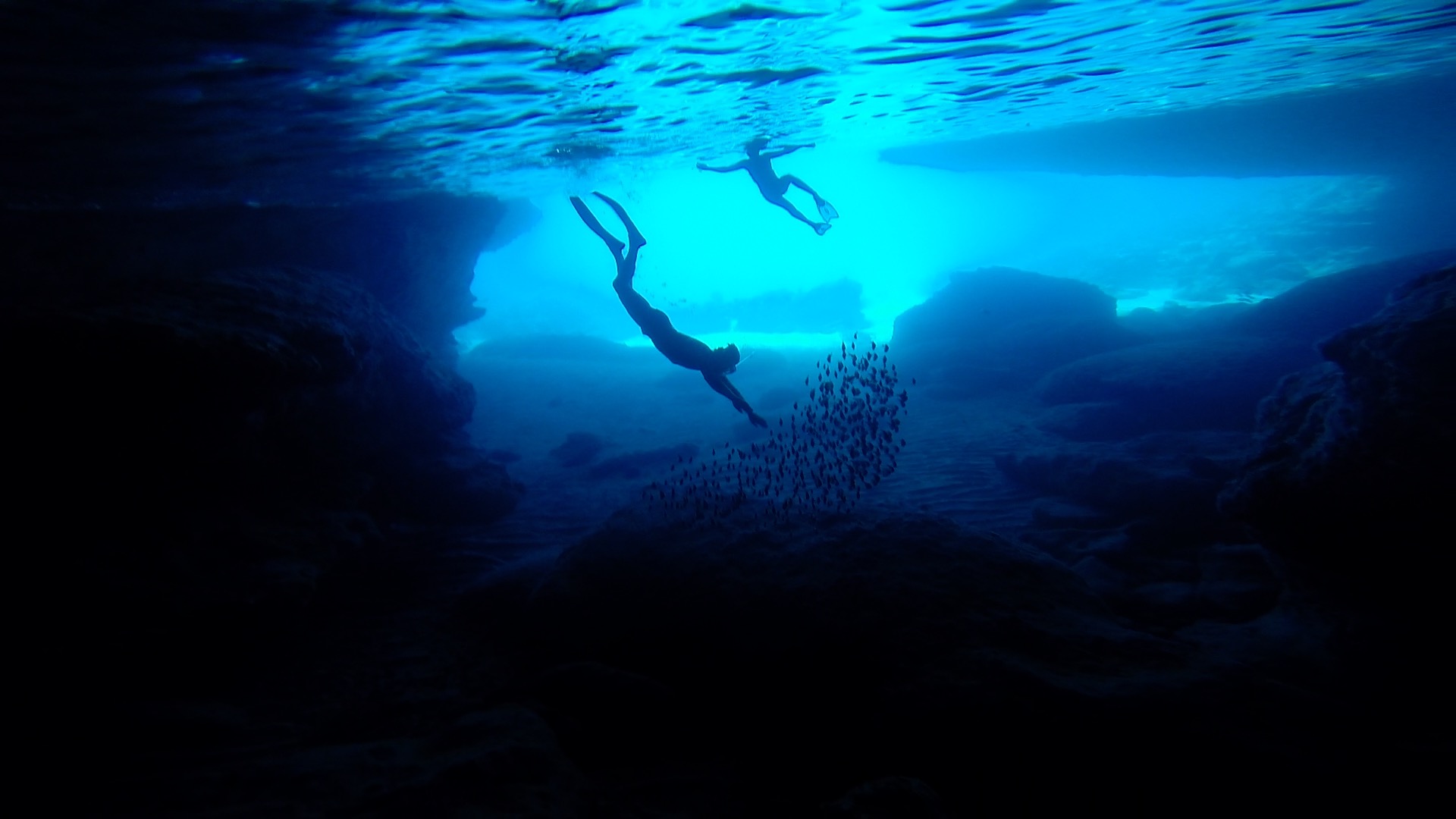
The Blue Room
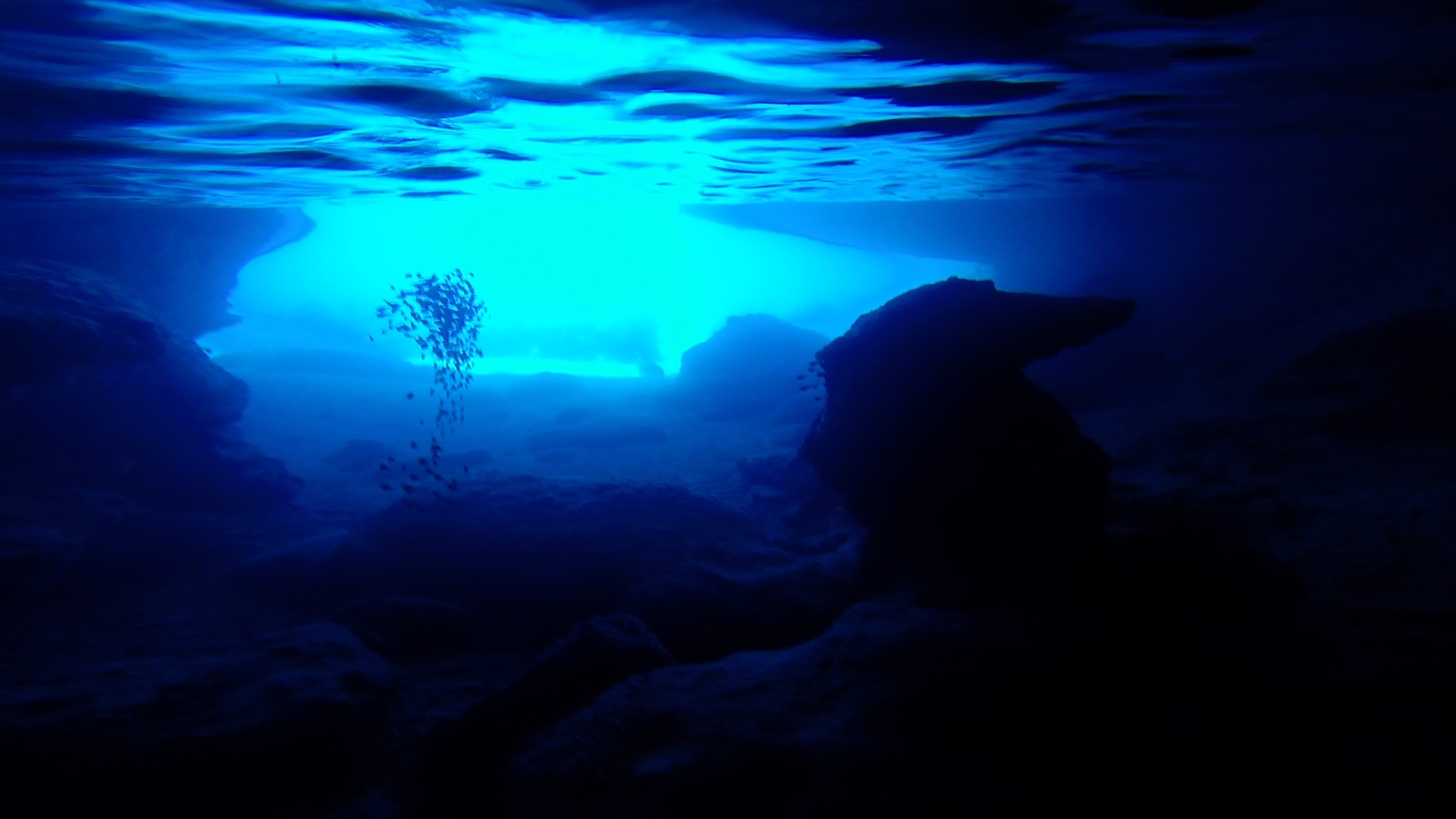
The Blue Room
The main town on the island, Willamstad, has three music venues within walking distance of each other. One, Bar 27, has jet black walls, ceiling, floor and furniture, pictures of Jim Morrison, Kurt Cobain, Jimi Hendrix, Amie Winehouse and Janis Joplin on the walls and plays the sort of music suggested by the décor from a large stage and powerful sound system. I loved it. Another, called Miles (as in Davis) is a tiny jazz club about a third of which is occupied by the stage. There’s standing room only inside where it’s ear-splittingly loud, roasting hot and the seething mass of bodies sways to the rhythm in the tropical night. But the crowd and the music spills onto the street outside where the volume and temperature are more moderate. Down the road is another bar where Latin tempos rule. Those outside just listen while those inside dance the night away.

Within walking distance of the anchorage is a large holiday resort called Zanzibar. It’s not the sort of place my friends and I normally frequent. But there’s a huge bar built right on the beach that has live music two nights a week. On Saturdays it’s packed and loud, on Wednesdays the sounds are mellow, a sort of Curacao version of the Café del Mar. Being local, we could just drop in, and we did.
Mostly, however, life was lived in and around the boats, rather than on the island, and it became pleasantly routine. For exercise my friends and I tried to swim every day though enthusiasm for this waned for a while after Ulrike was badly stung by a jellyfish. On most mornings Carin came over to Moonrise for coffee, and on many evenings I joined Ulrike and Matthias on their boat to watch the sun go down while listening to each other’s play-lists in company sufficiently familiar that silences had long since ceased to be uncomfortable.
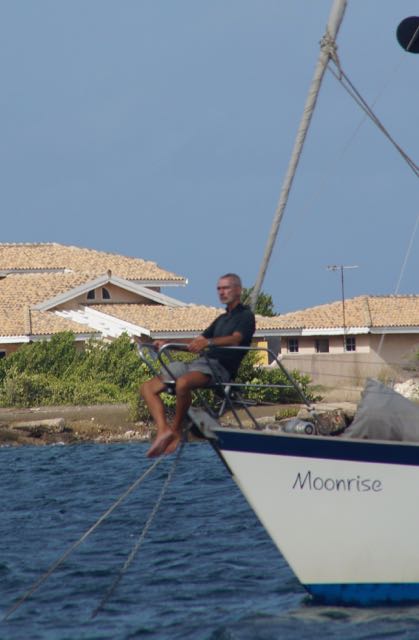
So a generally pleasant time, then. But there was more to it than that. When living an itinerant lifestyle, always moving on after a week or two, it’s good occasionally just to stop for a while, to get to know a place better than one does on a brief visit. On Curacao, the journey to the shops became familiar, as did the bus drivers who worked the route between the town and the anchorage. You could refer to “that grumpy one” and other cruisers would know whom you meant. I was on first-name terms with the people in the chandlery and knew my way around town, where to get good coffee and which cashpoints usually worked. I had a favourite walk in some hills next to the anchorage and got to know it well. And in an old nearby fort I found a peaceful place to sit for a while and gaze out to sea.
And then there were the people. That same itinerant lifestyle that means nowhere becomes truly familiar also means that nascent friendships tend to flicker and die as everyone moves ever onwards. But in Spanish Water we all settled down for the duration of the hurricane season. For once, our neighbours would be our neighbours for months, not a week or so, and a most remarkable phenomenon occurred: a bunch of people who have chosen to live their lives away from mainstream society formed a community. There were three catalysts that hastened this process: the Captains’ Dinner, the shopping bus and the radio net.
Once a week a restaurant on the shores of Spanish Water served a set menu dinner for a relatively cheap price, called it the Captains’ Dinner, and encouraged the cruisers to come. And come they did. Dozens of dinghies were tethered to the restaurant’s dock, tables were pushed together and the cruisers drank some, dined together, drank some more, then climbed into their dinghies again and disappeared into the night, leaving the restaurant’s few other diners looking somewhat bemused.
Then there was the shopping bus. One of the out-of-town supermarkets provides a free bus service from the dinghy dock to the shop and back every morning. It was always full so I’m sure it was a worthwhile investment for them. But it did wonders for the community, too. As time passed, faces became familiar, conversations were struck up (in the way that simply doesn’t happen on a London bus), information was exchanged and arrangements were made to meet later for drinks.
Finally, there was the radio net. We all have radios on our boats and every morning at eight o’clock the net’s host for that day would run through a prescribed list of questions. Does anyone need help or advice? Is anyone offering anything for sale, trade or give-away? Does anyone know of any events going on that may be interesting? Those with anything to contribute chipped-in under the appropriate topic. Actually, not much was bought or sold, and while there was some useful information occasionally, this was rare. The net’s value was not in the content of the broadcasts but in creating the idea that there was a community.
So that’s the recipe: take a bunch of itinerant cruising sailors and put them in one place for a while. Add a regular social event, a shopping bus and a radio net, bake under the tropical sun for a week or two and voila! a community develops that resembles a village in all but physical form. There were the usual characters: those who knew everyone within days of arriving and were generally much about the place, and those who were never much more prominent than “that bloke on the boat over there”. There were those who foisted their advice and views on anyone who stood still for long enough, and those who gently and kindly offered help and genuine expertise. There were loud ones and quiet ones, the stunningly boring and the frankly rather strange. All of life, it seemed, was there.
In due course things got organised. There were yoga classes and Spanish lessons, flea markets and hikes up nearby hills. An eighteenth birthday party was held on a deserted island, with barbeques, a bonfire and beer. There were seminars on cruising in Colombia, Cuba and the Pacific. The same talks were regarded by some people as invaluable sources of information and by others as merely opportunities for those who like the sound of their own voices to hold forth. Either way, they were well attended.
There were downsides to the community, too. The gossip was deafening. Is she sleeping with him? She spends a lot of time on his boat, I’ve noticed. Hmm. And that couple is always fighting on that boat, you know. Some of it was true, some of it was not, and some of it was unkind. And there were cliques, of course, manifestations of the desire to be “us” that requires a “them”. But for the most part everyone rubbed along pretty well together. As a social experiment it was fascinating to watch but it was also good to be a part of it. When constantly on the move one tires of forever being in a place but not of it, and my time in Spanish Water was a chance to be of a place, to a degree, for a while.
And then it was gone. The hurricane season ended and, one by one, we sailed away. The floating village dissolved as quickly as it had coalesced just six months before, and I too headed out to sea once more.
Hi James
meant to reply to this blog sooner but Malc’s extended hospital stay prevented that! So wonderful to hear all your news and we are so jealous to read all about the fantastic snorkelling experiences, and life in another part of the world. Happy sailing
Hi Val – good to hear from you! Hope Malc’s doing okay. A long recovery I guess.
Hello James.
Enjoyed reading your post. Since we were in Spanish Water ar the same time, it was extra interesting. Your way of describing is very good and we recognize a hole lot of it. We just met Bella again here in Isla de Mujeres, Mexico, and they told us we should read your blog. Glad we did. Best of luck and fair winds in your future adventures.
Hugs from Thea and Ragnar on Kattami.
Well hello Thea & Ragnar. It’s great to hear from you! And I’m glad you liked it. Say hi to Bella if you’re still with them.
Dear James, I have just been looking at your blog and really enjoyed it. Don’t forget your suncream. Love June Pryer
Thanks June! Glad you liked it.
Hi James, as always a very thoughtful and interesting blog. All the best, Dave
Cheers Dave!